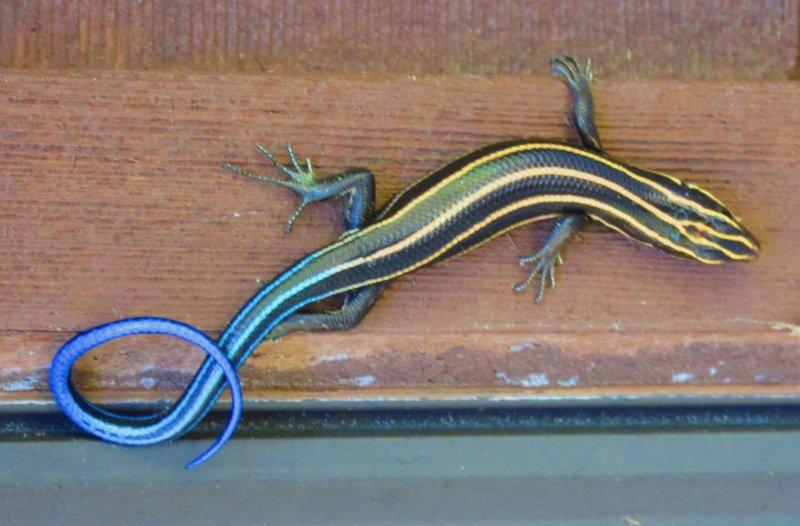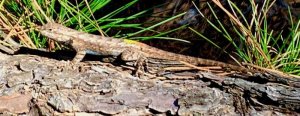Native lizards are quiet, discreet, alert and very good climbers
Imagine my friend Nancy’s surprise. She stepped out her front door on a crisp, dewy morning to watch the sunrise. Eyes surveying the beauty of her gardens with thoughts of exploring, she casually began to slip on her damp tennis shoes. Her bare toes unexpectedly met something cool and moving! Both creatures startled, and the shoe was suddenly vacant. A small, striped lizard flashing a neon-blue tail soundlessly left the scene with great speed.
Perhaps you have met a common five-lined skink (Plestiodon fasciatus) sunning on your cement step, visiting a damp corner of your shed or crossing the trail at the McCabe Nature Preserve in Milton. At first glance (and this skink moves quickly), you may observe a pointed head and a narrow body with bright-yellow stripes and short legs. You note that it was found in a dark, damp place (maybe a bucket of shallow water) and its skin had a glossy sheen. Maybe you once uncovered an adult with dark stripes in a decaying log.
These clues may lead you to falsely conclude it is a salamander in the amphibian family. The five-lined skink is actually a reptile that does not hesitate to enter water, which adds to false identification. All reptiles have dry skin made of overlapping scales. Most species have young that look like miniature adults and hatch from shelled eggs. “Skink” is a Greek word that dates back to the late 1500s. It was used to describe the many lizards found in Asia and North Africa, and the name has stuck around.
In addition to the five-lined skink found in a variety of wooded and urban habitats, our Cape Region supports two other native lizard species. Look for the eastern fence lizard (Sceloporus undulatus) in sandy, dry habitats and pine woods like those of Redden Forest and Cape Henlopen State Park. It is often camouflaged while basking on the trunk of a pine tree or a split-rail fence. It has a pattern of brown-and-tan markings, and a rough texture due to the backward-pointing projection on each keeled scale. Adult males have a blue belly patch. While a tail supports balance in all species, it is especially helpful for the arboreal (tree-dwelling) fence lizard.
Finally, the secretive little brown skink or ground skink (Scincella lateralis) is “fossorial,” which is defined as living in the leaf litter on the forest floor. I keep looking for this elusive 3- to 6-inch, golden-brown to dark-brown lizard. It has flat scales, and guidebooks explain that it may be mistaken for a snake. The legs are close to the body, and it moves through decaying leaves with a side-to-side motion. These non-venomous lizards are all active during the day. Some may be found basking in the sun to warm their body temperature, building energy that will enable quick reflex movements for feeding or escape.
As reptiles, these animals regulate their body temperature by sitting in the sun or moving into the shade. They are ectothermic, meaning their body temperature is directly related to their external environment. Lizards have a keen sense of sight and smell, as well as external ear openings on each side of the head to hear low frequencies. Our local species are carnivores, using their tongue to catch insects, spiders, earthworms and centipedes. They have tiny teeth to cut food into bite-size portions. To avoid predators, a speedy exit is always their first choice! If cornered, these lizards may exhibit a variety of defense postures, including flattening or puffing up their bodies to look bigger and more threatening.
Remember the neon-blue tail on the young five-lined skink? Eye-catching, isn’t it? A predator, or an enthusiastic naturalist, may pounce on the tail to catch this skink, but be left holding a detached and twitching tail while the animal runs away. This fascinating process called “autotomy” is perceived as instantaneous, but it is actually a series of escalating steps to ensure escape. Autotomy begins with the skink reflexively contracting muscles to create a weak zone or “fracture plane” between vertebrae. Under continued threat, an enzyme (collagenase) is released that begins to break down the proteins in the tail in the weak zone. Finally, the skink whips the tail back and forth until it snaps off. A healthy skink will grow a new tail in just a few weeks!
Visit delawarenaturally.org/native-plants-and-animals to find information on the current status of amphibians and reptiles in Delaware.

















































